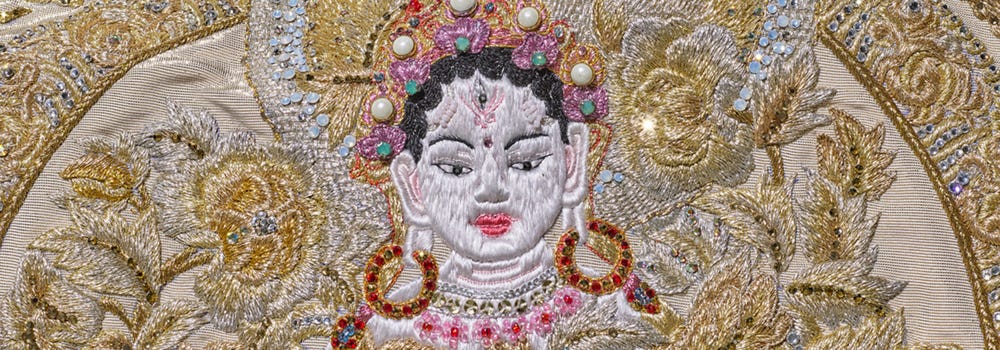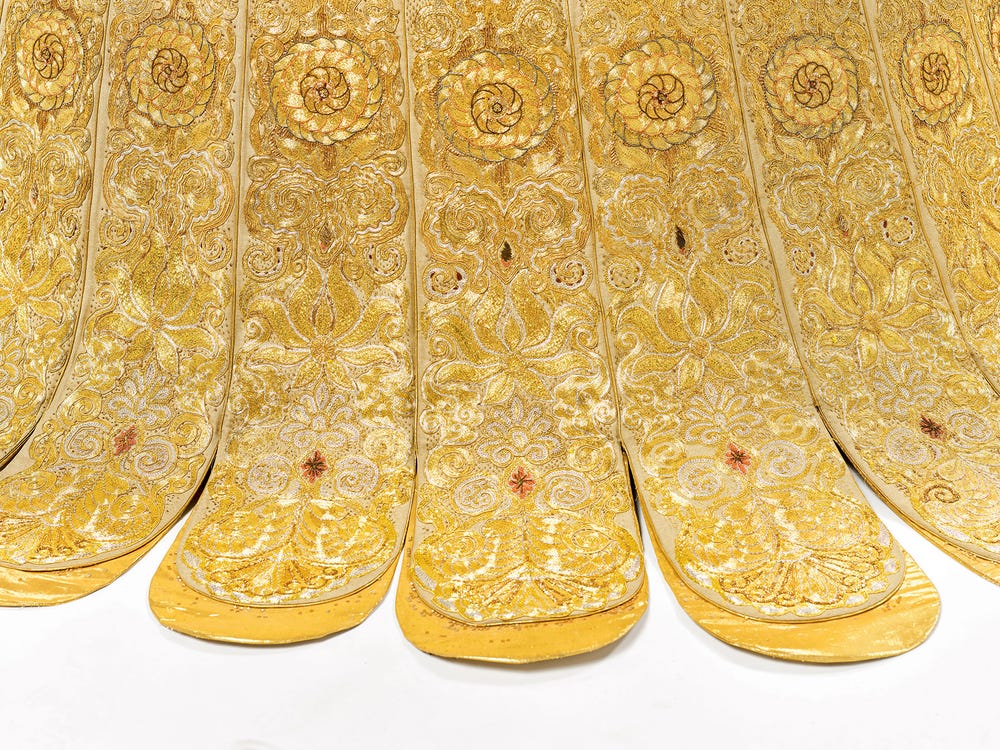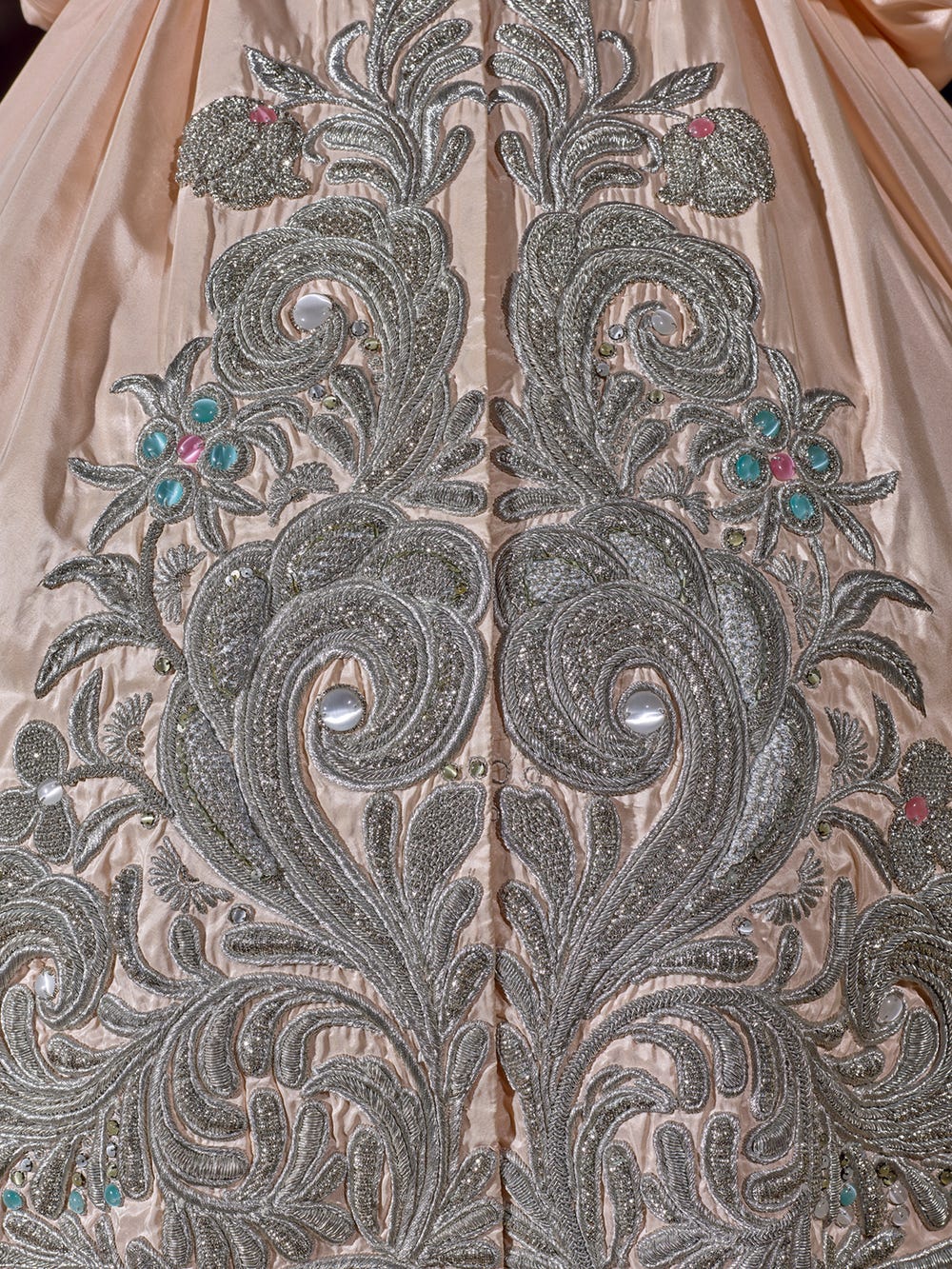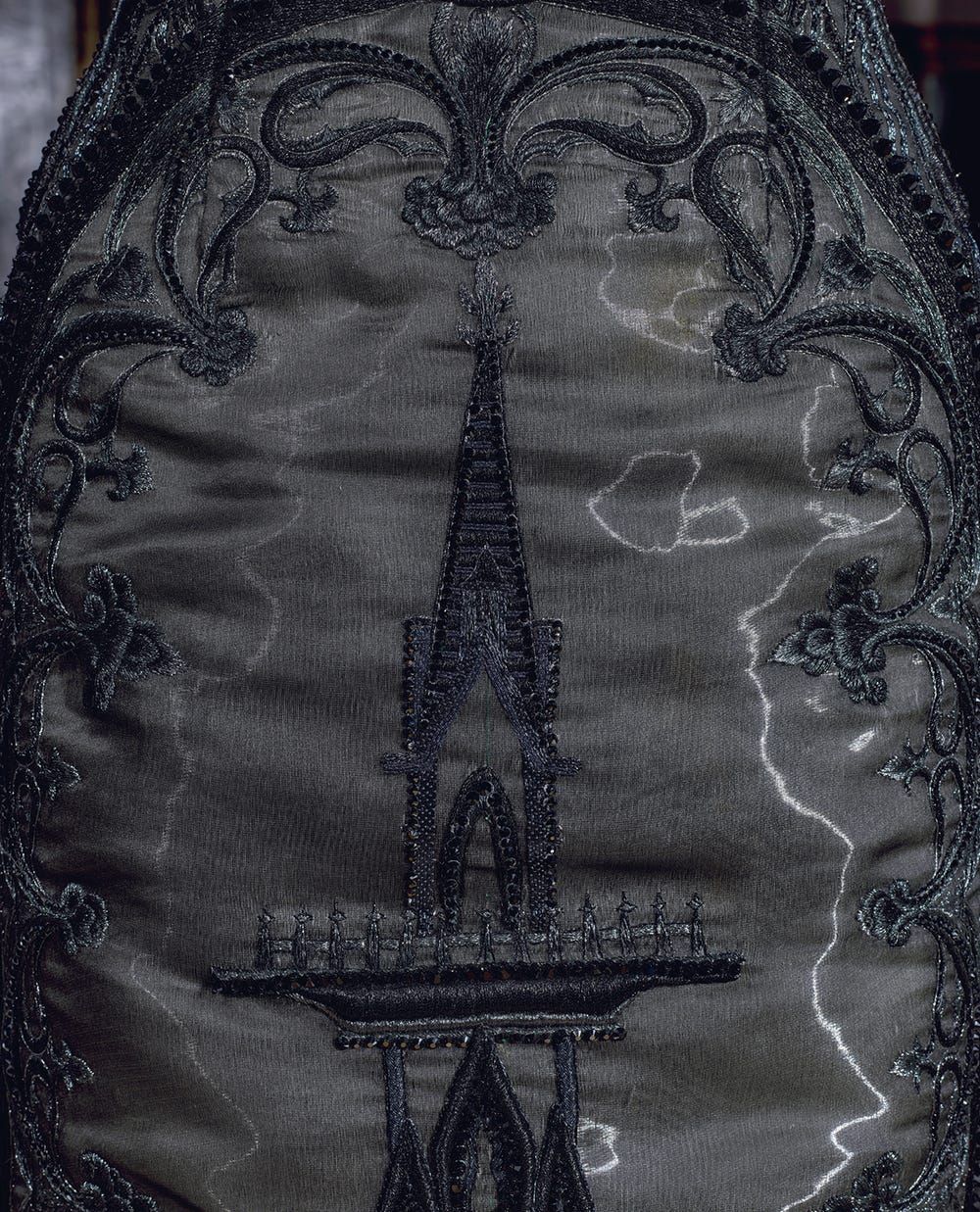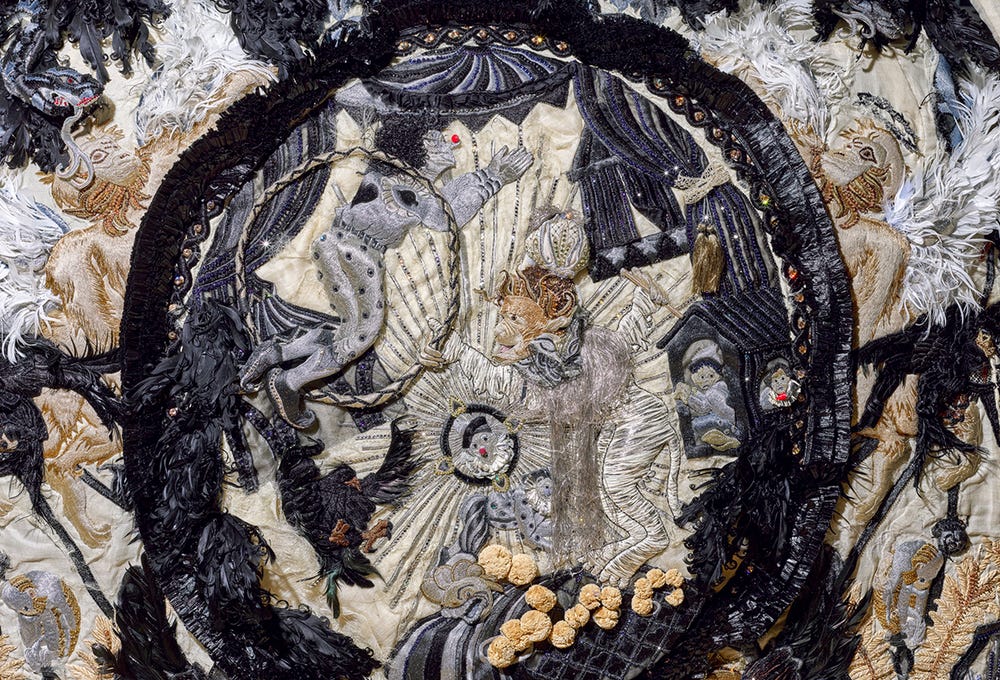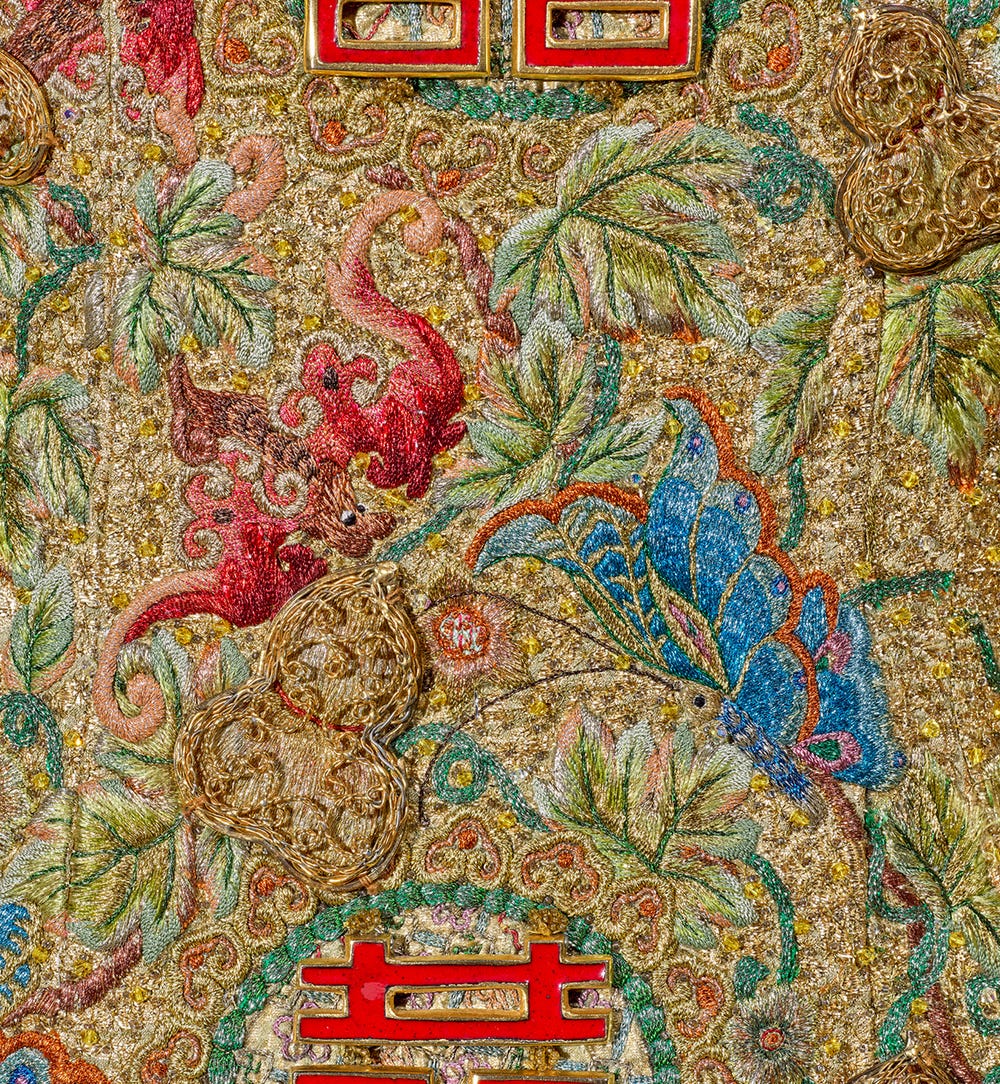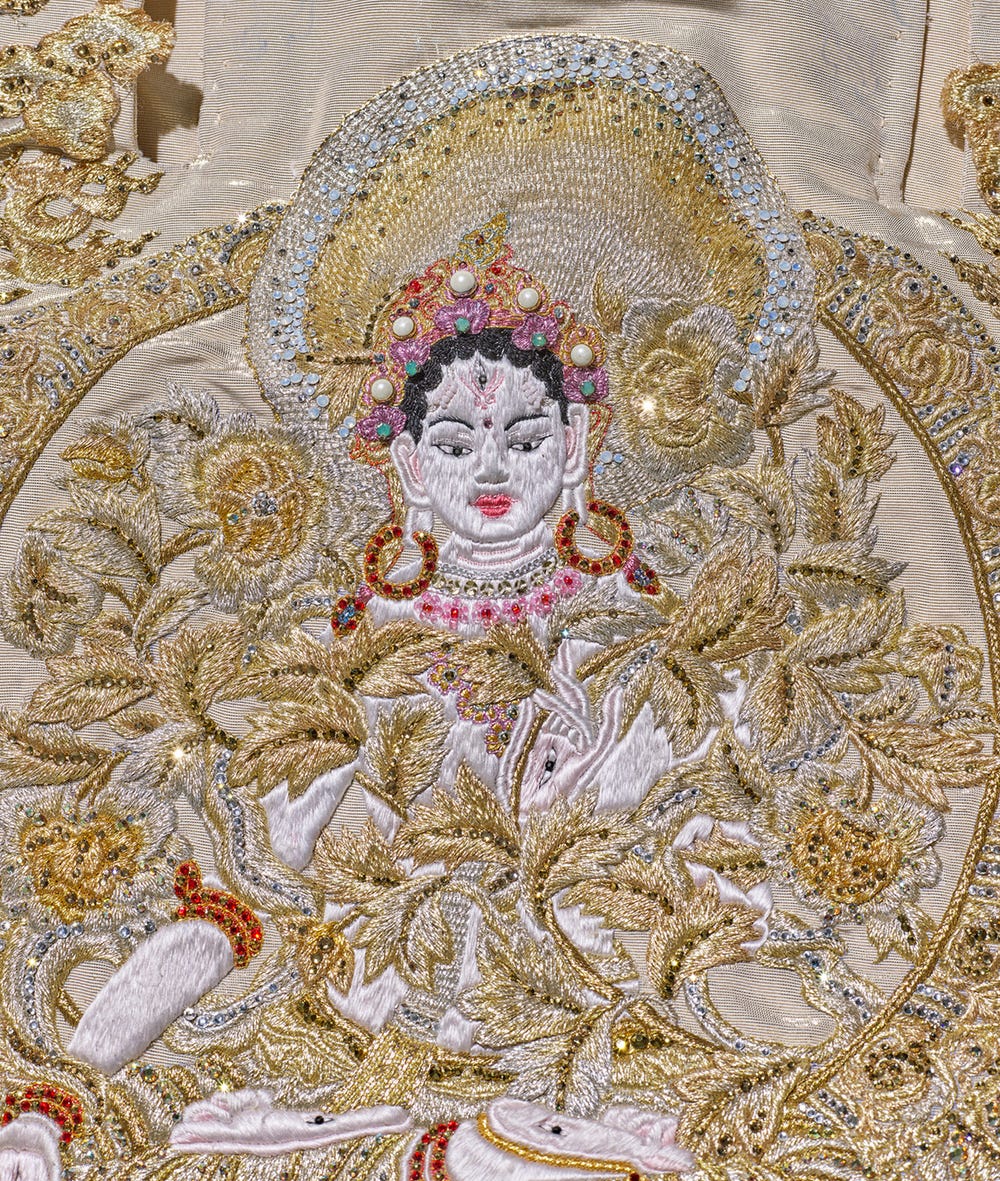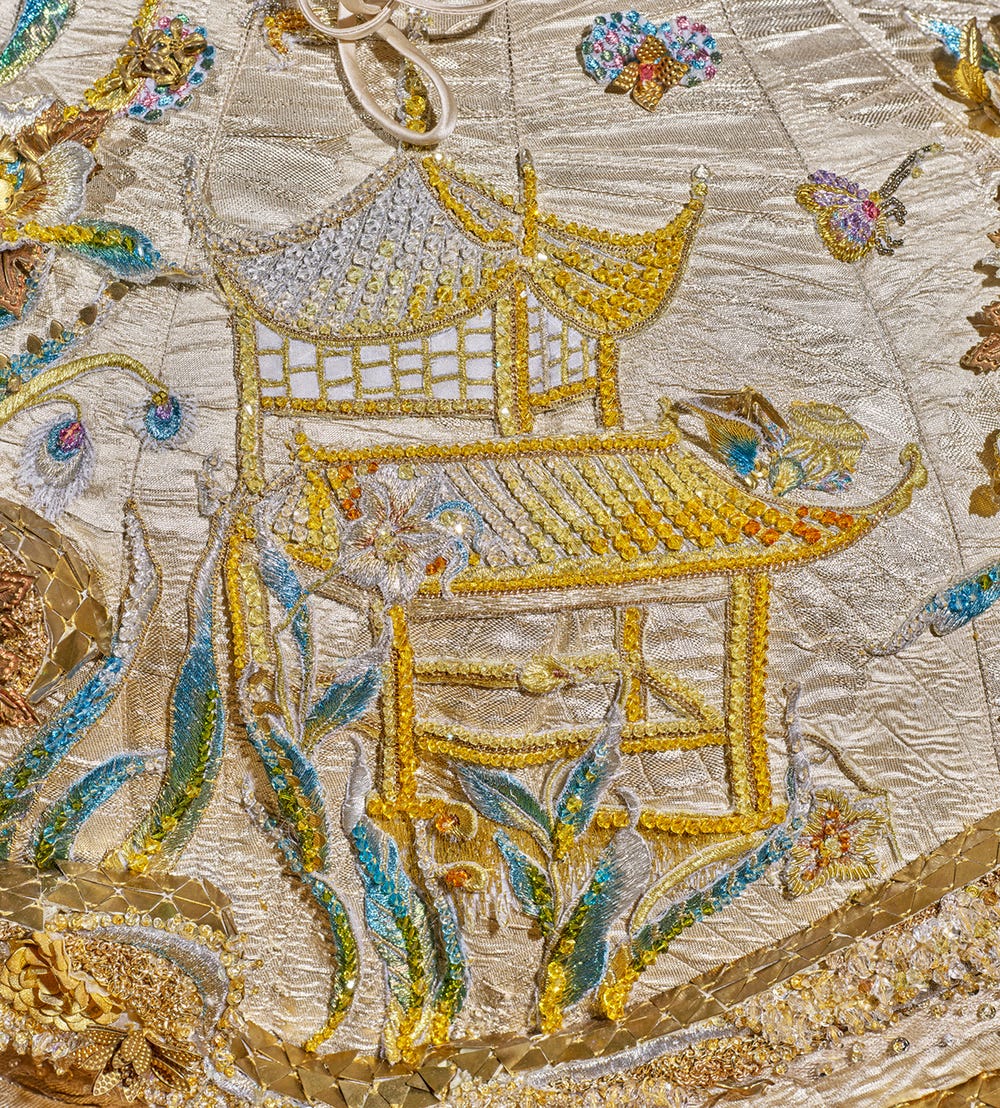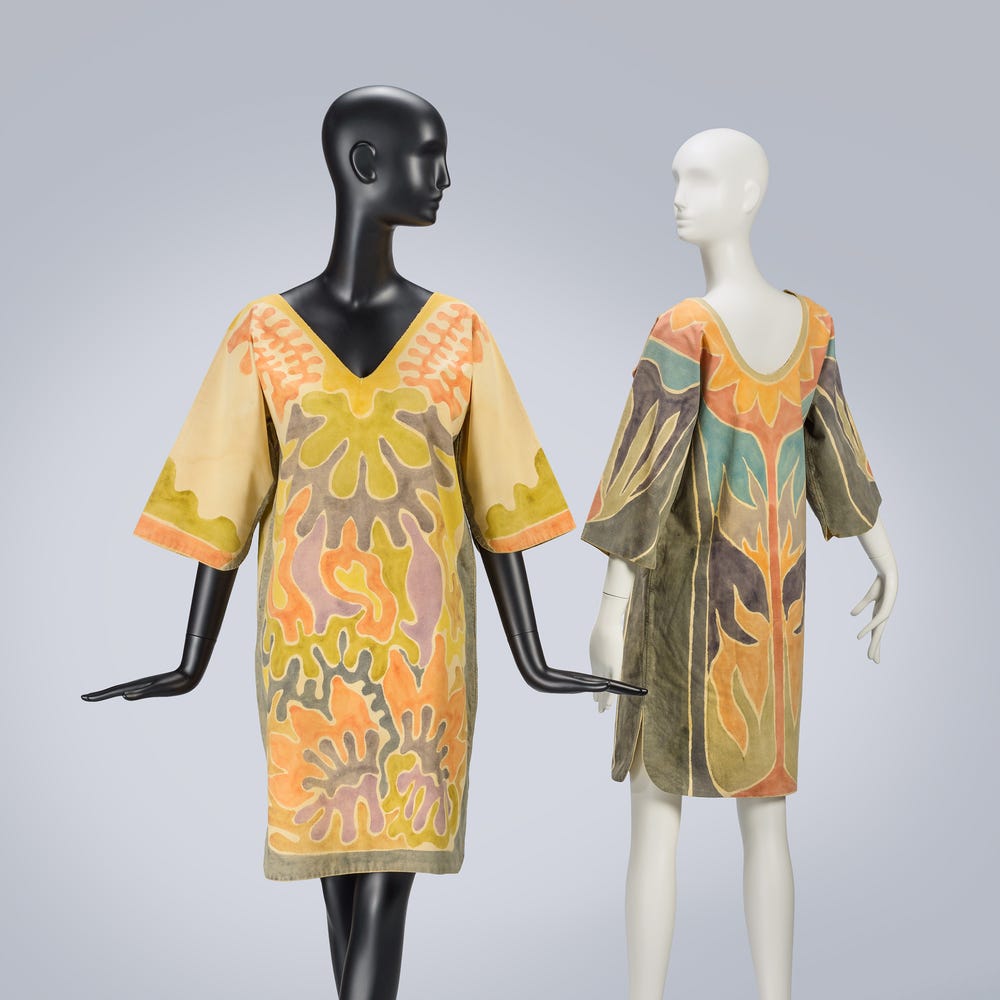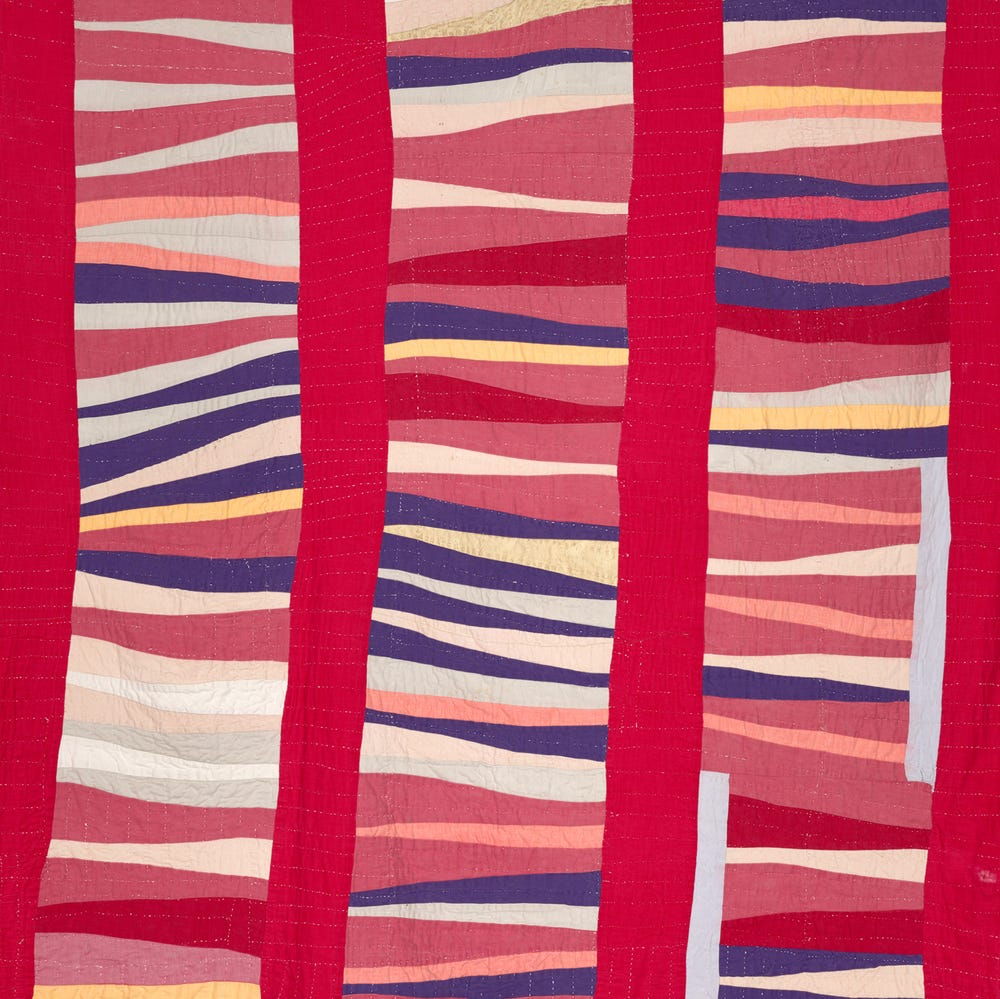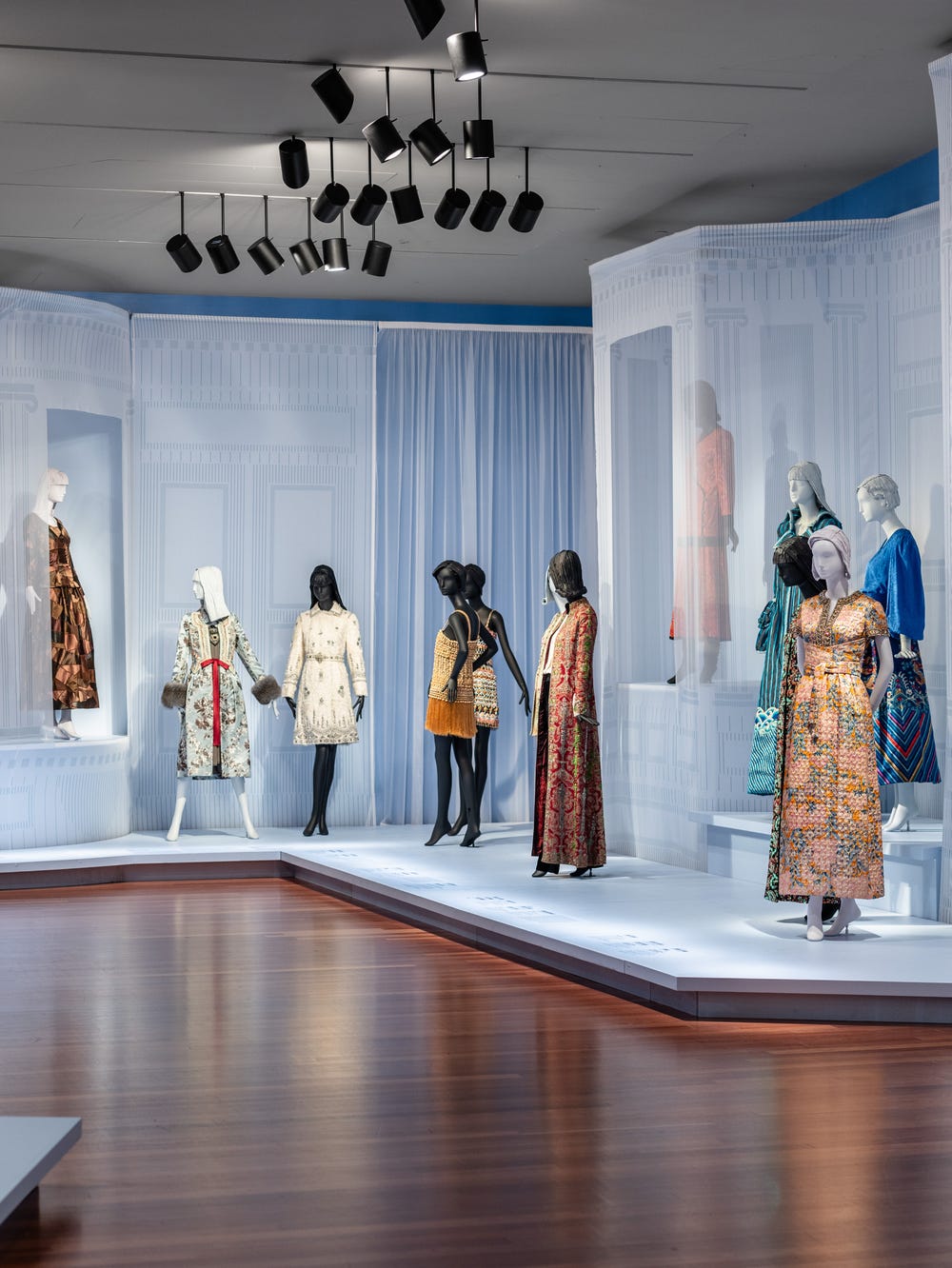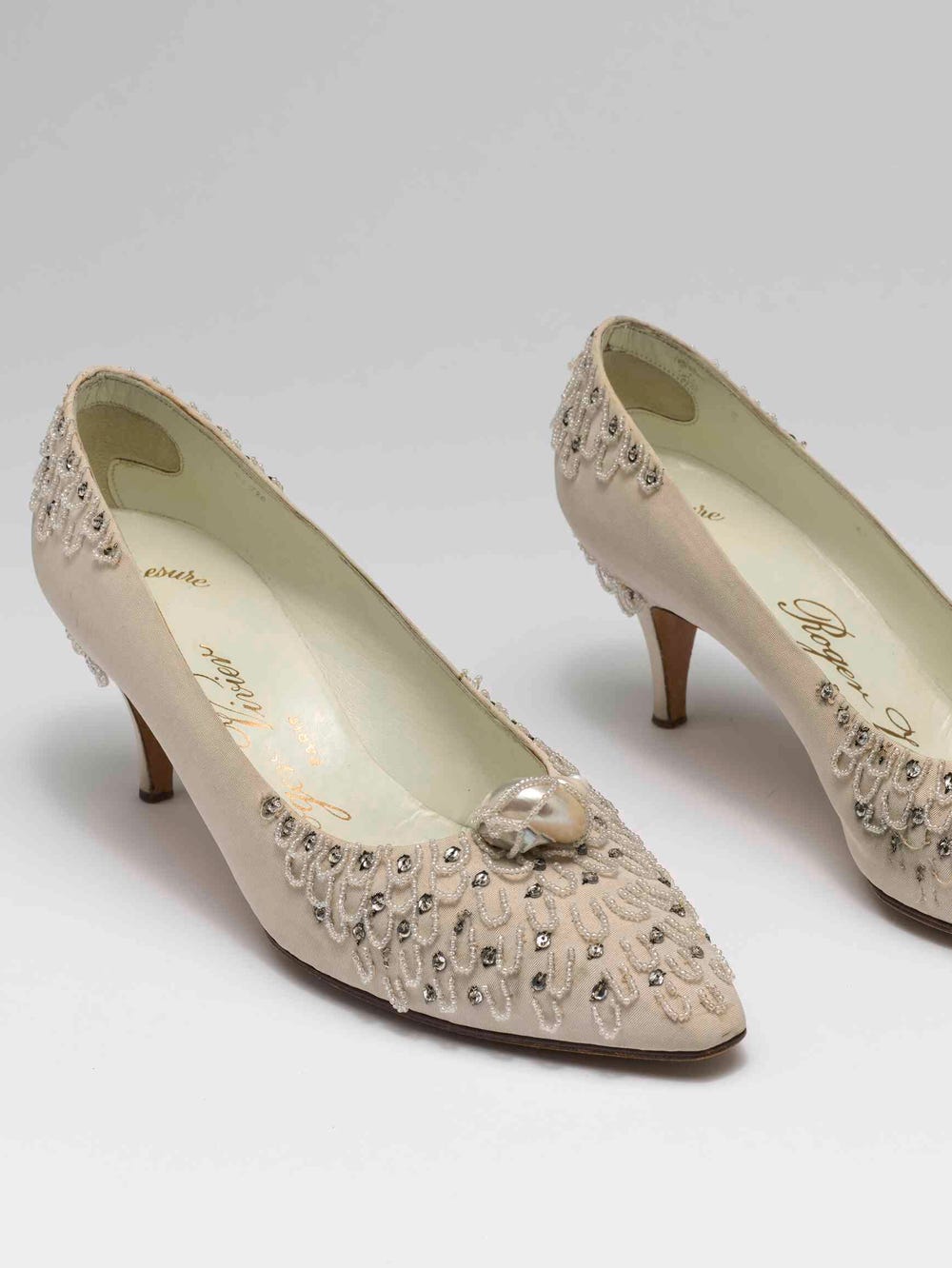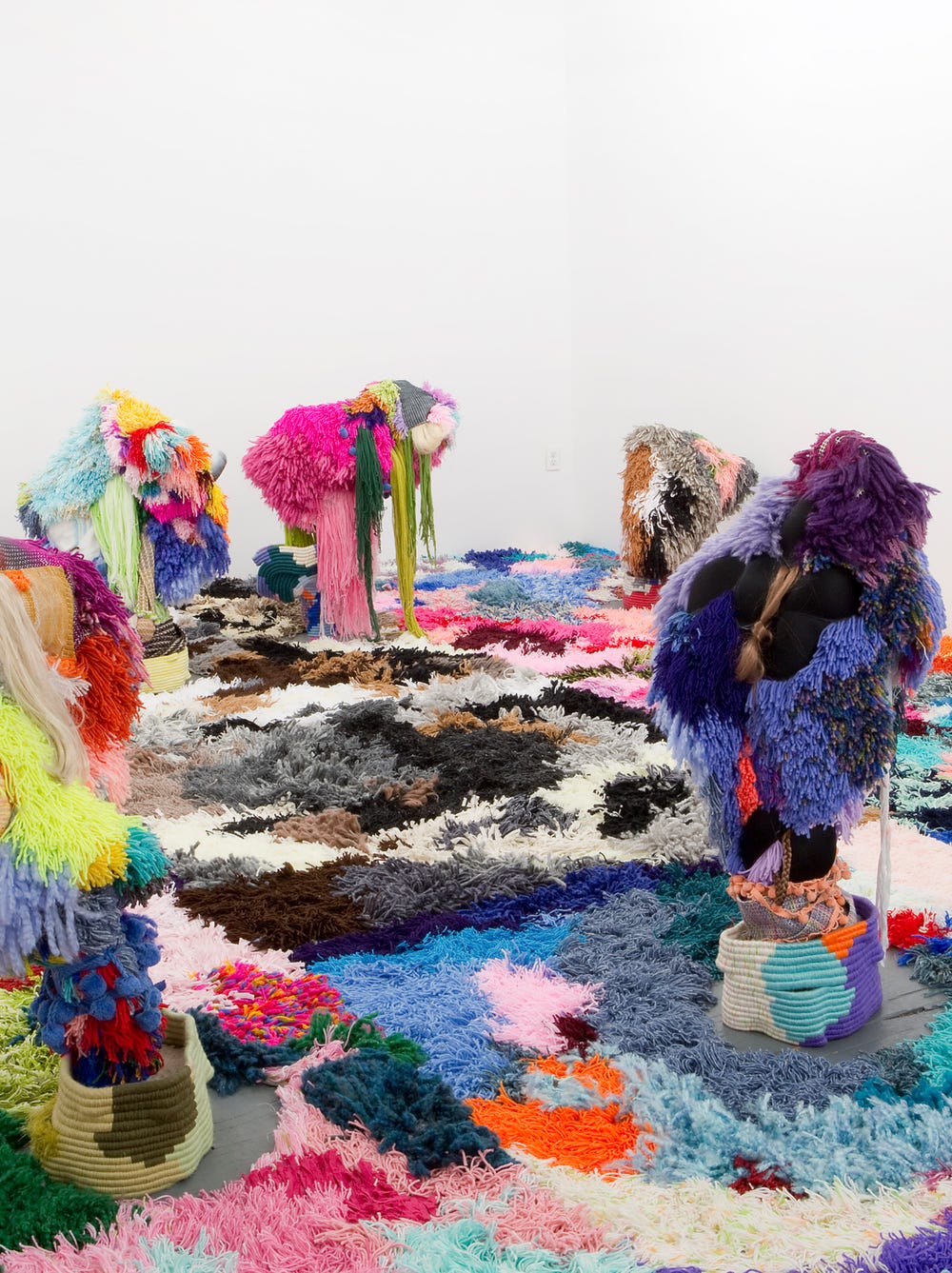Guo Pei’s Embroidered Universe: Stitch by Stitch
By Shao Xiaocheng
May 12, 2022
Guo Pei's embroidery designs are recognized worldwide for their uniqueness, intricacy, luxury, and extravagance. Let’s take a closer look at a few of her couture works.
Da Jin (Magnificent Gold), 2005
This piece is fully embroidered in gold with lotus flowers that combine Chinese embroidery techniques, Indian spring wire, and copper sheet material. The techniques include gold thread couching stitch (ding jin xiu), gold thread couching stitch (panjin xiu), running stitch (dian zhen xiu), chain stitch (la suo xiu), contour embroidery (lun kuo xiu), and beadwork (ding zhu xiu). The embroidery varies between richness and calmness, density and movement. Through an emphasis on craftsmanship and materials, Guo Pei achieves the highest possibilities of customization in couture embroidery. Expressing the enchantment of gold thread embroidery, this piece realizes a truly golden magnificence.
Guo Pei, Da Jin (Magnificent Gold), 2005 (detail). Copyright ©️ Guo Pei, Asian Couture Federation. All rights reserved. Photograph by Randy Dodson, courtesy of the Fine Arts Museums of San Francisco
An Amazing Journey in a Childhood Dream, Ensemble, 2007
With scrolling straw flowers embroidered in iron-gray silver silk, the garment combines spring wire embroidered flowers and leaves with petal patterns filled with square silk embroidery, complemented by colored beads. The stitches include slanted satin stitch (chan zhen), weaving stitch (bian zhi zhen), gold thread couching stitch (ding jin xiu), nailing stitch (ding zhen), and beadwork (ding zhu xiu). The embroidery is exquisitely worked, making the piece a beautiful example of couture handicraft.
Guo Pei, An Amazing Journey in a Childhood Dream, Ensemble (detail), 2007. Copyright ©️ Guo Pei, Asian Couture Federation. All rights reserved. Photograph by Randy Dodson, courtesy of the Fine Arts Museums of San Francisco
L’Architecture, Ensemble, Fall / Winter 2018 – 2019
The exquisite composition and fine techniques make this an outstanding example of embroidered clothing. The tower is embroidered with black thread and auxiliary materials. The stitches used to create the tower include gold thread couching stitch (ding jin xiu), straight satin stitch (ping zhen xiu), and sequin embroidery. Surrounding the tower are scrolling plants, which bring a solemnity to the tower and a tastefulness to the garment.
Guo Pei, L’Architecture, Ensemble (detail), Fall/Winter 2018–2019. Copyright ©️ Guo Pei, Asian Couture Federation. All rights reserved. Photograph by Randy Dodson, courtesy of the Fine Arts Museums of San Francisco
Alternate Universe, Two Person Dress, Fall / Winter 2019 – 2020
In this garment, Guo Pei uses embroidery to present the imagery of worldly beings in life and death. She places beings of the natural world within a circle. Techniques include appliqué embroidery (tie hua xiu), machine embroidery, padded satin stitch (dian gao xiu), stacked embroidery (dui xiu), appliquée diamond embroidery (zhan zuan xiu), and feather embroidery (yu mao xiu). She uses the language of embroidery to express respect and equality for worldly beings.
Guo Pei, Alternate Universe, Two Person Dress (detail), Fall/Winter 2019–2020. Copyright ©️ Guo Pei, Asian Couture Federation. All rights reserved. Photograph by Randy Dodson, courtesy of the Fine Arts Museums of San Francisco
Legend of the Dragon, Ensemble, 2012
This garment is fully embroidered with auspicious symbols, including bats, gourds, double lions, peonies, and butterflies. The materials have been applied in various ways. First, brocade gold jacquard fabric is used, so that there is enough space for the embroidery. The colored silk threads are combined with gold threads and gold spring threads. The bats are worked in red thread and set off against the golden gourds, creating a warm and prosperous feeling. The red double happiness character is worked in enamel, colorful embroidery, gold couching, appliqué embroidery, and other stitches in order to make it stand out. Here the embroidery not only creates subtle and beautiful traditional Chinese patterns but also integrates the luxurious atmosphere of Western bead embroidery.
Guo Pei, Legend of the Dragon, Ensemble (detail), 2012. Copyright ©️ Guo Pei, Asian Couture Federation. All rights reserved. Photograph by Randy Dodson, courtesy of the Fine Arts Museums of San Francisco
Himalaya, Ensemble, Spring / Summer 2020
To embroider a White Tara (an important figure in Buddhism, especially Tibetan Buddhism) thangka onto Chinese clothing is a work of both culture and art. It is a different technique than painting. To achieve the face of a Buddha that is compassionate but not sad, majestic but not angry, requires both superb embroidery skills and a peaceful state of mind. The key lies in the eyes of the Buddha statue. When embroidering, you must first burn incense and wash your hands. You must not be impatient or rushed. The eyes of the Buddha should be embroidered 30 percent open. In this way the Buddha’s face will appear solemn and compassionate.
The designer has meticulously depicted and described all the Buddhas and gods in the thangka world. The ornaments, crowns, and rosary beads of the Buddha are decorated with colorful gemstones. The Buddha is embroidered with colored silk threads, set against the holy light embroidered with gold and silver metallic threads. The combined effect is a radiant magnificence.
The White Tara is embroidered in satin stitch (tao zhen), net stitch (wang zhen), slanted satin stitch (chan zhen), weaving stitch (bian zhi zhen), padded satin stitch (dian gao xiu), beadwork (ding zhu xiu), stem stitch (you zhen), tent stitch (dian zhen xiu), couching stitch (ding xian xiu), and other embroidery methods. The lotus flower in the Buddha's hand is embroidered with transitional gold thread and colored thread. Padded satin stitch (dian gao xiu), satin stitch (tao zhen), straight satin stitch (zhi zhen), and slanted satin stitch (chan zhen) are all commonly used stitches in Chinese embroidery. However, the strength of gold thread makes this embroidery especially difficult. Even more commendable is the way Guo Pei has ingeniously applied handicraft skills. For example, the branches of the lotus are hand-woven and then sewn and embroidered onto the flower stem. White pom-poms are also affixed around the Buddha to express the holy mood.
Guo Pei, Himalaya, Ensemble (detail), Spring/Summer 2020. Copyright ©️ Guo Pei, Asian Couture Federation. All rights reserved. Photograph by Randy Dodson, courtesy of the Fine Arts Museums of San Francisco
Garden of Soul, Ensemble, 2015
This work innovates upon traditional embroidery materials. In addition to silk thread, appliqué embroidery, and machine embroidery, jewelry accessories are also used: small golden ginkgo leaves, tree leaves, chicken hearts, triangles, flower leaves, metal chains, and so on. These components, interspersed among the silk thread–embroidered flowers and leaves, create a unique style. The crystal diamond beads are also used in the main material of the couch-stitch embroidered pavilion.
Gold and silver metal thread is used to embroider the panes of the pavilion with slanted satin stitch (chan zhen), as well as the tile grooves and the pavilion top and columns. Next, white, yellow, and orange hexagonal crystal beads are layered onto the gold and silver embroidery. The background color of the gold and silver metal threads is visible through the transparent crystal beads, bringing a glittery translucence to the top of the pavilion. The outlines of the pavilion are couched in slender metal thread, making the entire structure appear to be bathed in a glorious and luxurious sunlight. The flowers, butterflies, grass, and winding paths of the courtyard are machine-embroidered, then appliquéd and hand-embroidered with large and small beads and various decorative pieces to make each component even more dimensional and lively.
Guo Pei, Garden of Soul, Ensemble (detail), 2015. Copyright ©️ Guo Pei, Asian Couture Federation. All rights reserved. Photograph by Randy Dodson, courtesy of the Fine Arts Museums of San Francisco
Guo Pei's garment designs inherit the aesthetics of Chinese embroidery, with traditional standards such as flatness, brightness, evenness, rhythm, and fineness. But they also incorporate the use of gold and silver metal thread to produce ornate scrolling grass and patterns of old European architectural ornament and metallic carvings. They combine accessories, beadwork, featherwork, and weaving, mixing in hand and machine embroidery to create an aesthetic full of sumptuousness and grace. The designs manifest both tradition and the designer’s ingenuity. Guo Pei’s courageous pursuit of fusing the cultural languages of Chinese and Western embroidery is the essence of her open mindset to creativity.
Text by Shao Xiaocheng, director of the Beijing Shao Xiaocheng Embroidery Research Institute.
Guo Pei: Couture Fantasy is on view at the Legion of Honor from April 16 through September 5, 2022.
Sources
- Josiane Bertin-Guest, Chinese Embroidery: Traditional Techniques (Krause Pubns Inc, 2003).
- Dieter Kuhn and James C. Y. Watt, eds., Chinese Silks (New Haven: Yale University Press, 2012).
- Shao Xiaocheng, Chinese Embroidery: An Illustrated Stitch Guide (Betterlink Press Incorporated, 2014).
- Wang Yarong 王亚蓉, Zhongguo minjian cixiu 中国民间刺绣 (Chinese Folk Embroidery) (Taibei: Diqiu Chubanshe, 1986).
- Zhao Feng 赵丰, Sichou yishu shi 丝绸艺术史 (Chinese Silk Art) Hangzhou: Zhejiang Meishuyuan Chubanshe, 1992).
